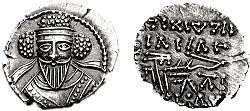Vologases V
| Vologases V | |
|---|---|
 Coin of Vologases V | |
| King of Arsacid Armenia | |
| Reign | 180 – 191 |
| Predecessor | Sohaemus |
| Successor | Khosrov I |
| King of the Parthian Empire | |
| Reign | 191 – 208 |
| Predecessor | Vologases IV |
| Successor | Vologases VI |
| Died | 208 |
| Issue |
Rev I Vologases VI Artabanus V Khosrov I |
| House | Arsacid dynasty |
| Father | Vologases IV |
| Religion | Zoroastrianism |
Vologases V of Parthia (Parthian: Walagash, Persian: بلاش, Balāsh), known in Armenian sources as Vologases II (Armenian: Վաղարշ, Vagharsh), was king of Arsacid Armenia from to 180 to 191, and king of the Parthian Empire from 191 to 208. He was the son of Vologases IV (147–191).[1]
Reign
During his early life, he became the ruler of Armenia, succeeding Sohaemus. During his rule in Armenia, he managed in 189 to impose his son Rev I (whose mother was the sister of the Pharnavazid ruler Amazasp) on the Iberian throne. Vologases, after the death of his father, ascended the Parthian throne, and appointed his son Khosrov I as the ruler of Armenia. Vologases' succession, however, was not uncontested; a rival King, Osroes II (190), had already set himself up in Media before the death of the previous ruler, but Vologases V appears to have quickly put him down.
Vologases V was attacked by the Roman emperor Septimius Severus (193–211) in 195. Severus advanced into Mesopotamia, occupied Nisibis and plundered the Parthian capital Ctesiphon in 199, capturing many Parthians and selling them into slavery. He attempted in vain to conquer the Arabic fortress at Hatra. In 202, peace was restored, leaving the Roman Empire in effective control of the whole of Mesopotamia.[2]
Vologases V died in 208, and was succeeded by his elder son Vologases VI (208–228), but a younger son, Artabanus V (216–224), rebelled and a civil war ensued.[3]
References
- ↑ Ahmad Hasan Dani, History of Civilizations of Central Asia, (Motilal Banarsidass, 1994), 474.
- ↑

- ↑ Chang Kuan-ta, The crossroads of civilizations: A.D. 250 to 750, (Imprimerie Darantiere, 1996), 35.
Sources
- Toumanoff, Cyril (1986). "Arsacids". Encyclopaedia Iranica, Vol. II, Fasc. 5. Cyril Toumanoff. pp. 525–546.
- Chaumont, M. L. (1988). "BALĀŠ". Encyclopaedia Iranica, Vol. III, Fasc. 6. pp. 574–580.
- (in French) Continuité des élites à Byzance durant les siècles obscurs. Les princes caucasiens et l'Empire du VIe au IXe siècle (Christian Settipani)|Continuité des élites à Byzance durant les siècles obscurs. Les princes caucasiens et l'Empire du VIe au IXe siècle, 2006.
- (in French) Les dynasties de la Caucasie chrétienne de l’Antiquité jusqu’au XIXe siècle ; Tables généalogiques et chronologiques, Rome, 1990.
- The Third-Century Armenian Arsacids: A chronological and Genealogical Commentary, Revue des Études Arméniennes #6 (1969) pages 233-281.
Vologases V | ||
| Preceded by Vologases IV |
Great King (Shah) of Parthia 191–208 |
Succeeded by Vologases VI |